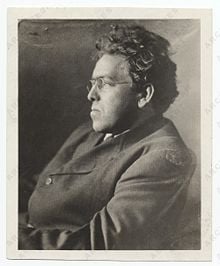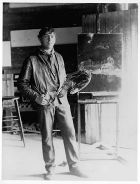Encyclopedia, Difference between revisions of "N. C. Wyeth" - New World
(1st 100) |
|||
| Line 22: | Line 22: | ||
| awards = | | awards = | ||
}} | }} | ||
| − | '''Newell Convers Wyeth''' (October 22, 1882 – October 19, 1945), known as '''N.C. Wyeth''', was an [[United States|American]] [[artist]] and [[illustrator]]. | + | '''Newell Convers Wyeth''' (October 22, 1882 – October 19, 1945), known as '''N.C. Wyeth''', was an [[United States|American]] [[artist]] and [[illustrator]]. He was the star pupil of [[Howard Pyle]]'s art school in [[Wilmington]], [[Delaware]] and went on to become one of America's greatest illustrators. During the "golden age of illustration" he created nearly 4,000 works over a 40 year period from 1903 to 1945. |
| + | |||
| + | In 1911 he gained national recognition with his illustrations for the book ''Treasure Island'' by [[Robert Louis Stevenson]] and went on to illustrate many other children's classics for [[Charles Scribner's Sons|Scribner's]]. | ||
He was the father and founder of an artistic dynasty that includes son [[Andrew Wyeth|Andrew]] and grandson [[Jamie Wyeth|Jamie]]. | He was the father and founder of an artistic dynasty that includes son [[Andrew Wyeth|Andrew]] and grandson [[Jamie Wyeth|Jamie]]. | ||
| − | + | His love for America - its individuality and its landscapes - is clearly evident in his works from the [[Old West]] to the "Brandywine Hill" country of [[Chadds Ford]], [[Pennsylvania]]. His bold and sometimes massive artwork is said to express his "largeness of spirit"; one biographer said of Wyeth, "he painted murals on a heroic scale." <ref>Allen, Douglas and Allen, Douglas, Jr. ''N.C. Wyeth: The Collected Paintings, Illustrations and Murals,'' (1972)</ref> | |
| − | |||
| − | His love for America | ||
Revision as of 18:59, 11 June 2007
| N.C. Wyeth | |
 N.C. Wyeth ca. 1920 | |
| Birth name | Newell Convers Wyeth |
| Born | October 22, 1882 Needham, Massachusetts, United States |
| Died | October 19, 1945 Chadds Ford, Pennsylvania, United States |
| Nationality | American |
| Famous works | Treasure Island, Robinson Crusoe |
| Influenced by | Howard Pyle |
Newell Convers Wyeth (October 22, 1882 – October 19, 1945), known as N.C. Wyeth, was an American artist and illustrator. He was the star pupil of Howard Pyle's art school in Wilmington, Delaware and went on to become one of America's greatest illustrators. During the "golden age of illustration" he created nearly 4,000 works over a 40 year period from 1903 to 1945.
In 1911 he gained national recognition with his illustrations for the book Treasure Island by Robert Louis Stevenson and went on to illustrate many other children's classics for Scribner's.
He was the father and founder of an artistic dynasty that includes son Andrew and grandson Jamie. His love for America - its individuality and its landscapes - is clearly evident in his works from the Old West to the "Brandywine Hill" country of Chadds Ford, Pennsylvania. His bold and sometimes massive artwork is said to express his "largeness of spirit"; one biographer said of Wyeth, "he painted murals on a heroic scale." [1]
Biography
Like Amercian illustrator Norman Rockwell Wyeth found early producing illustrations for The Saturday Evening Post. A bucking bronco for the cover of The Saturday Evening Post on February 21 1903 was Wyeth's first commission as an illustrator.[2] That year he described his work as, "true, solid American subjects–nothing foreign about them."[3] His early trips to the western United States inspired a period of images of cowboys and Native Americans that dramatized the Old West.[4]
Significant public collections of Wyeth's work are on display at the Brandywine River Museum in Chadds Ford and the Farnsworth Art Museum in Rockland, Maine.
N.C. Wyeth died in an accident at a railway crossing along with his grandson (Nathaniel C. Wyeth's son) near his Chadds Ford home in 1945.
Influences and Art
Indian Art
Religious pictures
He also illustrated editions of The Yearling, by Marjorie Kinnan Rawlings, Robinson Crusoe, The Last of the Mohicans, Kidnapped and Robin Hood.
Wyeth's pictures of the Old West were not only inspired by his first-hand experience but by the artist Frederic Remington who ...
His pictures of Indians were romantic and usually depicted them them alone in the wilderness.
Wyeth taught many art students, including his son. He learned from Pyle the concept of "mental projection." He would say, "don't just paint a sleeve, become the arm!",ref>Allen, Douglas and Allen, Douglas, Jr. N.C. Wyeth: The Collected Paintings, Illustrations and Murals,</ref> He used his own self as a model because he said that growing up on a farm gave him a sense of odily action - how the body looks and how it moves.
Wyeth was a realist painter just as the camera and photography began to compete with his craft.[5] Sometimes seen as melodramatic, his illustrations were designed to be understood quickly.[4] Wyeth who was both a painter and an illustrator, understood the difference, and said in 1908, "painting and illustration cannot be mixed–one cannot merge from one into the other."[5]
Legacy
As head of the Wyeth painting dynasty who lived and worked in picturesque Chadds Ford, Pennsylvania, his life is "larger than his accomplishments."
He is father of artist Andrew Wyeth, Henriette Wyeth Hurd, Carolyn Wyeth, Ann Wyeth McCoy, and Nathaniel C. Wyeth. Andrew, Henriette, and Carolyn became artists as well. Ann became an artist and composer. Nathaniel became an engineer for DuPont and worked on the team that invented the plastic soda bottle. Henriette and Ann married two of N.C.'s proteges, Peter Hurd and John W. McCoy. N.C. Wyeth is the grandfather of artist Jamie Wyeth and musician [[Howard Wyeth
Put more here...
Other works
- Mowing (1907)
- Long John Silver and Hawkins (1911)
- The Fence Builders (1915)
- Apotheosis of the Family (1932):[6] a 60-foot-by-19-foot mural including likenesses of members of the Wyeth family, located in a building in downtown Wilmington, Delaware[7]
- Dying Winter (1934)
- The Alchemist (1938)
- Deep Cover Lobsterman (1939)
- The War Letter (1944)
- Nightfall (1945)
- Stand and Deliver (19??) [7]
ReferencesISBN links support NWE through referral fees
- Allen, Douglas and Allen, Douglas, Jr. N.C. Wyeth: The Collected Paintings, Illustrations and Murals, (1972) ISBN 0517183358
- Michaelis, David. N.C. Wyeth: A Biography Alfred A. Knopf (1999) ISBN 0679426264
Notes
- ↑ Allen, Douglas and Allen, Douglas, Jr. N.C. Wyeth: The Collected Paintings, Illustrations and Murals, (1972)
- ↑ Gerson, Donna, Michelle Frisque, Beth Kean, and Elizabeth T. Mahoney (undated). Elizabeth Nesbitt Room Illustrators Project: Newell Convers Wyeth (1882-1945). University of Pittsburgh. Retrieved 2007-02-21.
- ↑ American Art Archives (undated). N C Wyeth / Newell Convers Wyeth. Retrieved 2007-02-21.
- ↑ 4.0 4.1 barewalls.com (1996-2005). Newell Convers Wyeth. Retrieved 2007-02-21.
- ↑ 5.0 5.1 Gopnik, Adam (November 15 1998). "Pictures Great," His Publisher Told Him, review of N. C. Wyeth by David Michaelis. New York Times. Retrieved 2007-02-18.
- ↑ Milford, Maureen, "WSFS building fills void in city's center", Delaware News-Journal, 7 January 2007. Retrieved 2007-01-07.
- ↑ 7.0 7.1 Milford, Maureen, "Wanted: New home for Wyeth painting", Delaware News-Journal, 25 January 2007. Retrieved 2007-01-26.
External links
- "Virtual tour of N.C. Wyeth's studio", Brandywine River Museum, Retrieved May 21, 2007.
- "Robinson Crusoe text with illustrations by N.C. Wyeth", N. C. Wyeth, Retrieved May 21, 2007.
- "N.C. Wyeth Biography", BPIB, Retrieved May 21, 2007.
- "Bronco Buster", Artsmia, Retrieved May 21, 2007.
- "Lesson Plan for grades 9-12: N.C. Wyeth: The Art of Illustration", ArtsEdge, Retrieved May 21, 2007.
Credits
New World Encyclopedia writers and editors rewrote and completed the Wikipedia article in accordance with New World Encyclopedia standards. This article abides by terms of the Creative Commons CC-by-sa 3.0 License (CC-by-sa), which may be used and disseminated with proper attribution. Credit is due under the terms of this license that can reference both the New World Encyclopedia contributors and the selfless volunteer contributors of the Wikimedia Foundation. To cite this article click here for a list of acceptable citing formats.The history of earlier contributions by wikipedians is accessible to researchers here:
The history of this article since it was imported to New World Encyclopedia:
Note: Some restrictions may apply to use of individual images which are separately licensed.



